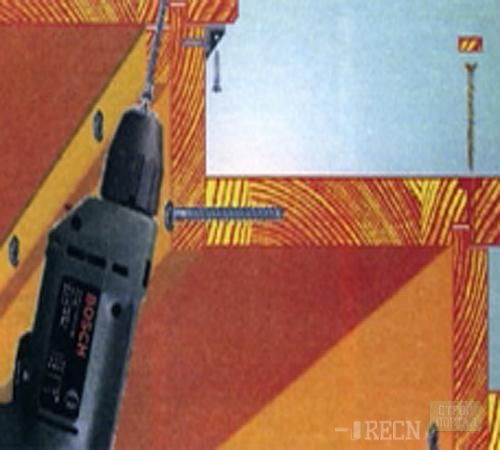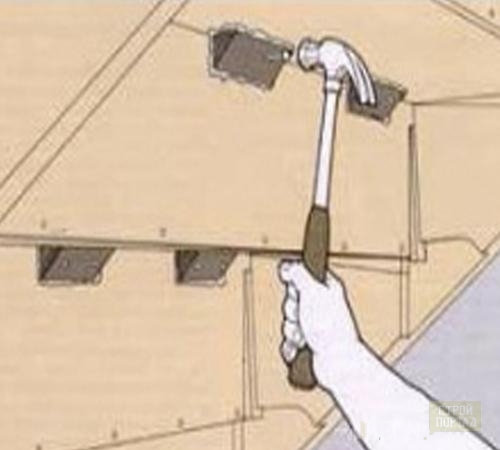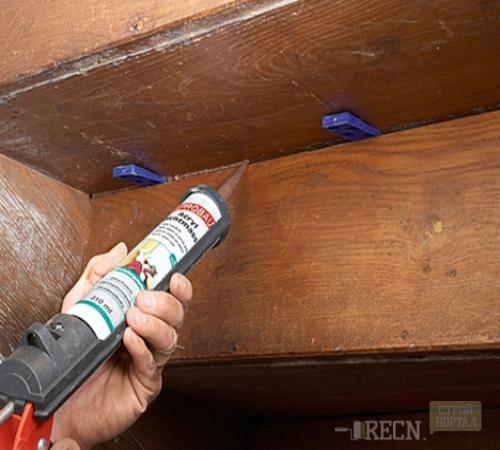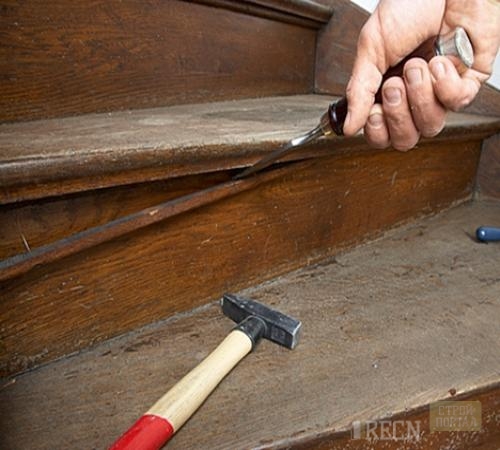
How to eliminate the script stairs Ladder

One of the most frequent troubles faced by the owners of old houses is an annoying creaking of a wooden staircase.
Content
Why creaks a staircase?
Most often, this is due to the fact that there is friction between the emergence and other parts of the staircase, due to the weak connection between them. This situation may arise for several reasons, for example:
1. Due to the shrinkage. If the unscrupulous masters in a hurry forgot to dry the wood properly and gathered a staircase from wet, then over time the water evaporated, and the details decreased in the amount - desole. Sometimes shrinkage reaches 7-8%, and this is enough that the staircase creak appeared thanks to the gaps.
2. Due to changes in shape, wear or destruction. Elements of the staircase daily and remember times are subjected to serious loads, so in the process of use they often deform or break. And if there is an increased humidity and temperature differences, then this process is twice as fast.
3. Due to loosening fasteners or dug out parts. Such a problem appears if there is poor-quality glue during installation, and for fixing parts - self-tapping screws. It is better to use nuts and bolts as fasteners, because They are easily twisted in case of relaxation of the connection.
4. Due to bad fit design elements. If inexperienced or unscrupulous masters allowed such an oversight, then after a while, under the action of loads, it will definitely be felt. It is better to check immediately before assembling the design all the places of connections than the last time to correct the shortcomings.
5. Due to the flexing of floors. If such a problem appeared, it will be extremely difficult to solve it. Sometimes it is necessary to even disassemble the design to the base. To prevent such a situation, before installing the ladder, you need to strengthen the floor. This is done with the help of special racks or an extra beam.
If the staircase creaks, what to do?
Sequence of actions to identify and eliminate the staircase screen:
1. First, inspect all the joints of the design elements. They should help as close as possible to each other, not allowing the possibility of education of gaps in the future. If all the same happened and the creak is distributed due to relaxed connections, then determine all the problem areas.
2. To identify them, remove carpets and other decorative coatings from the stairs if they are. Come on it in both directions. The task will be simplified in the presence of an assistant and free access to the upsembly space. One person will walk along the steps and call the numbers of those that creak, and the second, standing under them, celebrate places in need of repair.
3. When each creaking stage has been revealed, it is necessary to check for the subject matter of the site and beams, paying particular attention to the connecting and fasteners. If necessary, lubricate metal parts, equip the bolts with rubber gaskets.
4. During the movement on the stairs, the main burden falls on the steps most often suffer from the places where they are connected to other parts. If the sticky and the risers were mounted through nails, then over time they could deform or fall out, which led to the appearance of gaps.
5. If the space under the stairs is not busy, then strengthen the steps are best from there. With a slight defect, take a few additional nails, directing them at an angle regarding the sticky. True, it will not be so easy. The fact is that for the construction of stairs use wood, distinguished by special hardness and reliability. Because of this feature, it is almost impossible to drive a nail or screw the screw, not affecting damage. In this regard, before using metal fasteners, it is necessary to drill holes for it, a little smaller diameter.
You can not turn the fastener elements into the old holes, you need to make new, otherwise the connection will not be reliable.
6. If the removal is to establish that the staircase crepts due to the fact that the wedges are separated connecting to the approaches with the riser, disconnect them completely, polish so that the dried glue, lubricate the new, such as PVA, and attach to the old place.
7. If the cause of the screens lies in the wedges themselves who gave shrinkage, then they will have to put special planks for them, although it is easier and faster simply replace them with new ones.
8. If during the operation of the staircase, the slot between the details reached a decent dimensions, then before tightening them, you will have to fill the space with additional clins or straps. Formed seams for greater reliability should be missed by construction glue.
Repairing the staircase from the inside, level and join all the items so that they are not visible from the face.
If the pop-up space is fallen, and it is impossible to repair from the inside, then the option of raising the steps of the lever remains. Or rush wedges, and outstanding areas are scolded and grinding.
9. Also small wedges are needed if the gadgets are loosened. The glue is applied on them, and then ride from the inside of the staircase in the groove under the step.
10. Strongly discharged steps better to equip additional rigidity ribs. As they can serve as wooden bars mounted in the angle between the riser and coming and tightening them.
11. In some cases, the creak appears with the onset of a certain season. This is because from the intensified moisture, wood swells, and the details stop accurately fit into place. To prevent the appearance of such a problem, you need to process all the wooden surfaces in advance by the composition that prevents the penetration of moisture inside the material.
12. Another way out in the fight against seasonal creak is a sealant of silicone or paraffin. In the summer, we treat them all the place of the joints and the entry of parts in the grooves. The tool must be transparent so that in the corners of the design there are no spots of another color. After application, you should refrain from using the staircase to complete drying.
13. Professionals are recommended to insert rubber gaskets in those places where the details are drunk on each other, or glue a special tape compensating for the deformation of the material.
14. During the restoration of the ladder, it is better to establish any cargo on it, the weight of which is about 80 kg. It can be weights or a bag filled with sand.
15. Stairs, equipped with three cosos, most often begin to creak in the area that is in the middle. In this situation, the steps are additionally attached to the central beam using carpentry and fasteners.
Preventing the occurrence of a violep of a wooden staircase
Making conclusions from the foregoing, highlight the basic measures to be taken to ensure that the staircase does not start to creak with time:
1. The first thing to be done so that the design is not overlooked and does not begin to publish no other sounds - it takes it extremely seriously. Do not be lazy to seek the ideal docking parts and thoroughly dry wood before starting work.
2. Constantly maintain a stable level of humidity in the room, not to allow its oversupply, as well as temperature drops. Even if you have to spend money on a special technique, it will still be cheaper than to disassemble and restore the stairs.
3. It is better to take care of the elastic layers in the installation process in those places where creak occurs most often. To do this, the damper tape is perfect, which is a foamed polyethylene.
4. Use only high-quality and reliable fasteners, preferably metallic.
5. Choosing the type of fastener, it is better to give preference to the screws, bolts and washers, and the screws and screws to refuse. If the connection is still overwhelmed, then thanks to such a choice, the troubleshooting will take a minimum of effort.
6. When choosing the workers who will perform installation work, you should give preference to more experienced who work in a solid organization and have only positive feedback on their work. And let their work pays slightly higher than the handicraft masters. In this case, savings can get sideways, and ultimately turn into overrun.
To better understand how to eliminate the creak of a wooden staircase, see the following video:
























